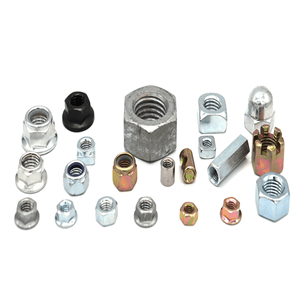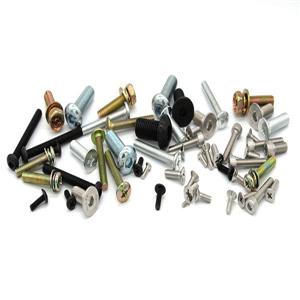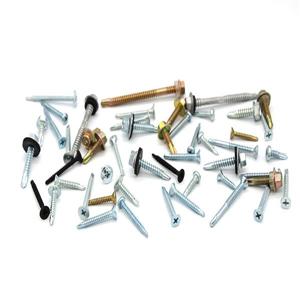On the selection of high-strength bolts and their product processing technology ...
Introduction
In the machinery manufacturing industry, a large number of bolt parts need to be applied. Bolt parts are divided into corresponding 10 grades according to their basic properties and performance. Among them, bolt parts with a performance level greater than 8.8 are called high. Strength bolts. High-strength bolts have higher strength and surface hardness, and can be widely used in metal smelting and machinery manufacturing industries. We should fully study the material selection and processing technology of high-strength bolts to ensure that high-strength bolts can meet the requirements of related industries. Demand, so as to enable products in various industries to carry out effective quality assurance, improve product safety and practicability, and then improve the economic and social benefits of related industries.
1 Material selection analysis of high-strength bolts
The material selection of high-strength bolts should be fully combined with its actual application scheme. The material selection of high-strength bolts may affect the life and processing method of the bolts in use. Therefore, you must be very careful when selecting materials. Next, provide several common materials for high-strength bolts for corresponding material selection research and analysis.
At present, in the selection of high-strength bolt materials, high-quality stainless steel and high-quality alloy structural steel and high-temperature alloy steel are preferred. Among them, high-quality stainless steel is 304 stainless steel, with a density of 7.93g / cm3, which is also called 18/8 stainless steel in the industry. It has a high temperature resistance of 800 degrees, good processing properties, and high strength and toughness. At present, the common marking methods are 00Cr19Ni10 and SUS304. The former indicates the national standard production, and the latter indicates the Japanese standard production.
Superalloy refers to a type of metal steel that uses iron-nickel-cobalt as the basic component and can work for a long time at a high temperature above 600 ° C and high strength stress. It has very high high temperature strength, good oxidation resistance and corrosion resistance. Properties, with good fatigue resistance and fracture toughness, high-temperature alloying degree is high, so it is also known as super alloy, high-temperature alloys are widely used in the processing of high-strength bolts.
Microalloyed steel is to add some elements to the steel for high-strength bolts to change the properties of the steel, to improve the performance and stability of the material, each element has its own role. When steel is used, the production process should be adjusted according to the different elements and contents. Currently, the widely used ML35 steel still has some problems in the production of bolts, which easily cause quench cracking and deformation. Therefore, CH35ACR cold heading steel and ML35 steel are replaced. CH35 steel is more suitable for the manufacture of bolts of larger sizes. Compared with ML35 steel, the content of Si and Mn are different. The former increases the addition of Cr, reduces the content of P and S, improves the anti-tempering performance of steel, and improves the rigidity after component processing. China's alloyed steel technology has also developed to a certain extent, adding less than 0.1% of carbide elements in steel, such as Ti, V, and Cr [1].
In general, after the corresponding heat treatment of medium carbon structural steel, strength and shape will increase and decrease each other, and high strength bolts need an organic combination of strength and toughness. In the study of low-carbon structural steel after quenching, it was found that the low-carbon martensite has higher strength and yield strength, and also has good toughness and shape. Development is of great significance. 15Mn-VB low carbon martensitic steel is able to produce bolts of grade 8.8-10.9, while 20Mn-VB low carbon martensitic steel has improved bolt strength and performance by 40% compared to 40Cr bolts. It can be effectively applied to important bolt structures in the machinery manufacturing industry, such as connecting rod bolts, cylinder head bolts, and axle bolts, which can greatly improve the yield of bolts and ensure the stability and support of the bolt structure. Reduced the safety hazards existing in the mechanical structure and created good social value [2].
2 Process analysis of high-strength bolts
High-strength bolts are an important standard part. They have a variety of designs and shapes, as well as a variety of external dimensions. However, there is a certain degree of similarity in the main structure and overall shape design. We divide bolts into bolt heads, bolt shanks, and threaded parts based on the similarity of high-strength spirals. High-strength bolts generally do not require a special dedicated working machine during processing, and can be completed on ordinary processing machinery. The bolt processing technology is also divided into three parts according to its shape and structure, which are bolt head processing, bolt rod processing, and thread processing. There is a certain correlation between the three processing technologies.
The main processing technology of the high-strength bolt head is the processing of bolt blanks in the form of cold-drawn square steel, and the technology of hexagon-head bolts is cold-drawn hexagon steel. The head of the bolt should be selected according to the specific needs of the design. If the accuracy of the head of the bolt is required, the forging blank should be used, and the overall pre-processing amount should be retained. Generally, 4 mm should be retained in the length direction. Left and right reserve, 1.5 mm allowance on the inner end face of the head. In order to ensure sufficient tensile strength of high-strength bolts during machining, chamfers are generally required at the inner end face, and the chamfer value is Rt according to 0.2. bolt
The head of the head should adopt the processing technology of upsetting. The general process is blanking-upsetting-pickling-trimming-Leguang six-sided S-face.
High-strength bolt rods are required to be able to play an effective guiding role so that they can produce rounded corners in contact with the bolt head to avoid fracture of this part during high-strength operations. In addition, it should be noted that the process cannot be applied to the upper portion of the rod. Causes cracks. The processing technology of the rod should take into account the thickness of the bolt rod. The slender rod should have a margin of about 1.5 mm. At the same time, it should try to prevent large deformation during heat treatment. Generally, the bolt rod needs to be HRC32. about. The surface defect of the forging should be no more than 0.3 mm, and the forging should be normalized to make it suitable for subsequent processing operations. The core technology of the rod processing is the processing of the outer circle of the rod. Generally, the combination of turning and grinding is used for processing. It can effectively ensure that the size of the bolt rod meets the technological requirements. A combination of large depth of cut and large feed should be used. When performing operations, it is necessary to effectively reduce the cutting speed; if there is a clear dimensional accuracy requirement for the bolt shaft, a margin of about 0.3 mm should be reserved on both sides [3].
The thread part of the bolt is the core part of the high-strength bolt. In the processing process, pay attention to the design of the pitch and the half-angle of the tooth profile to ensure the precision of the thread and other accessories, and also pay attention to the production efficiency. High-strength bolt threads are generally processed by rolling processing, which can effectively ensure the thread's
productivity. The materials are recombined to form the desired shape. After the rolling operation, the workpiece blank will grow relatively. The success of the rolling of the thread is largely related to the shape to be formed. If the bolt head has a correspondingly required vertical bolt, the thread must be accurately trimmed in the form of a grinding wheel. The rolling process can effectively save more than 16% of the raw materials, and a certain retract distance must be reserved at the lower end of the thread, which is about 2 to 3 mm. For bolts with anti-fatigue requirements, strict heat treatment should be carried out, and quenched and tempered thread rolling technology should be used to control the manufacturing process of the thread rolling wheel, so as to ensure the smoothness of the thread bottom, prevent the inside of the thread from folding, and fillet the head. Roll strengthening to prevent excessive stress concentration.
3 Development Trend of High Strength Bolt Products
With the diversified development of the machinery industry, more and more stringent requirements have been imposed on the fasteners inside the machinery. Vehicle fasteners must meet high-performance and lightweight designs, which not only increases the cost of parts manufacturing, but also increases the overall cost of the machine. At present, only through the application of high-strength bolt products can the mechanical industry fasteners be effectively met. Requirements. In the future development process, high-strength bolt products will be widely used in the machinery industry. Its sufficient mechanical strength and high toughness and shaping will improve the quality of the machinery industry and machining. With the continuous development of the times and Reform, high-strength bolts will continue to optimize their product attributes with the development of the machinery manufacturing industry, so as to provide relevant industries with more high-quality bolts that meet requirements [4].
4 Conclusion
High-strength bolts can provide high-strength and high-toughness bolt structures for related industries, thereby reducing the cost burden of related industries and improving the economic benefits of various industries. This article takes the selection of high-strength bolts as the entry point, in-depth discusses several materials applied to high-strength bolts, and discusses the processing techniques of the bolt's head, rod, and thread positions, thereby promoting high-strength bolts. Improvements and optimizations to enhance its strength, toughness, and plasticity, and strengthen its wide application in the machinery industry, thereby promoting related industries to achieve their own economic value and social benefits.




